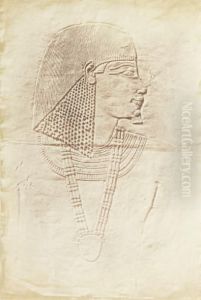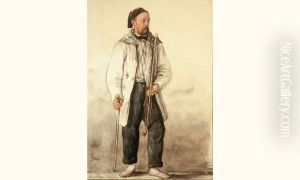Theodule Deveria Paintings
Théodule Augustin Deveria was a French photographer and Egyptologist born in 1831 in Paris, France. He was the son of the painter Achille Devéria and followed in his father's artistic footsteps, but found his true calling in the emerging field of photography. Deveria's early work in the arts was overshadowed by his interest and contributions to Egyptology, a field that was gaining significant interest in Europe after Napoleon's campaign in Egypt and the subsequent scholarly work that emerged from it.
Deveria's photographic career began in the 1850s when he worked at the studio of his brother-in-law, the photographer Gustave Le Gray. During this period, he honed his skills in the new art of photography, which was rapidly developing and becoming more popular. His work included portraits, archaeological subjects, and reproductions of artworks, demonstrating a wide range of interests and technical skills.
In Egyptology, Deveria's most significant contribution came from his work as a member of the French-Egyptian Commission for the Description of Egypt. He traveled to Egypt in 1855 where he took over 200 photographs documenting Egyptian monuments and hieroglyphs, many of which were deteriorating due to exposure to the elements and vandalism. His photographs provided an invaluable record for scholars and the public, who were fascinated by ancient Egypt.
Despite his promising career, Théodule Deveria's life was cut short when he died in 1871 at the age of 40. His death marked the loss of a talented photographer and a dedicated Egyptologist. However, his contributions to the documentation of Egypt's ancient heritage continued to be recognized and used by researchers and historians. Deveria's photographs are still considered an important resource for understanding Egypt's archaeological past and the history of photography.

